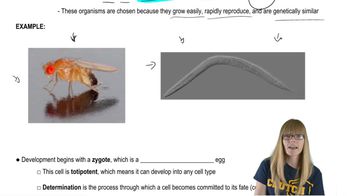Should fertility clinics be required by law to disclose that some assisted reproductive technologies (ARTs) can result in epigenetic diseases? How would you and your partner balance the risks of ART with the desire to have a child?
Table of contents
- 1. Introduction to Genetics51m
- 2. Mendel's Laws of Inheritance3h 37m
- 3. Extensions to Mendelian Inheritance2h 41m
- 4. Genetic Mapping and Linkage2h 28m
- 5. Genetics of Bacteria and Viruses1h 21m
- 6. Chromosomal Variation1h 48m
- 7. DNA and Chromosome Structure56m
- 8. DNA Replication1h 10m
- 9. Mitosis and Meiosis1h 34m
- 10. Transcription1h 0m
- 11. Translation58m
- 12. Gene Regulation in Prokaryotes1h 19m
- 13. Gene Regulation in Eukaryotes44m
- 14. Genetic Control of Development44m
- 15. Genomes and Genomics1h 50m
- 16. Transposable Elements47m
- 17. Mutation, Repair, and Recombination1h 6m
- 18. Molecular Genetic Tools19m
- 19. Cancer Genetics29m
- 20. Quantitative Genetics1h 26m
- 21. Population Genetics50m
- 22. Evolutionary Genetics29m
13. Gene Regulation in Eukaryotes
Epigenetics, Chromatin Modifications, and Regulation
Problem 19b
Textbook Question
A developmental disorder in humans called spina bifida is a neural tube defect linked to a maternal diet low in folate during pregnancy.
Does this exclude genetic mutations as a cause of this condition?
 Verified step by step guidance
Verified step by step guidance1
Understand the context: Spina bifida is a neural tube defect influenced by both environmental factors (e.g., maternal diet low in folate) and genetic factors. The question asks whether genetic mutations can also contribute to this condition.
Clarify the role of folate: Folate is crucial for DNA synthesis and repair during early development. A deficiency in folate can disrupt normal neural tube closure, increasing the risk of spina bifida. However, this does not rule out genetic contributions.
Explore genetic factors: Genetic mutations in genes involved in folate metabolism (e.g., MTHFR gene) or neural tube development (e.g., VANGL1, SHROOM3) can predispose individuals to spina bifida, even in the presence of adequate folate levels.
Consider gene-environment interactions: Spina bifida is often the result of complex interactions between genetic predispositions and environmental factors, such as maternal folate levels. Both components can play a role in the condition's development.
Conclude: While a maternal diet low in folate is a significant risk factor, it does not exclude genetic mutations as a cause of spina bifida. Both genetic and environmental factors contribute to the condition, and their interplay is critical in understanding its etiology.
 Verified video answer for a similar problem:
Verified video answer for a similar problem:This video solution was recommended by our tutors as helpful for the problem above
Video duration:
1mPlay a video:
Was this helpful?
Key Concepts
Here are the essential concepts you must grasp in order to answer the question correctly.
Neural Tube Defects
Neural tube defects (NTDs) are serious birth defects that occur when the neural tube, which forms the brain and spinal cord, does not close completely during early fetal development. Spina bifida is one of the most common NTDs, characterized by incomplete closure of the spinal column, leading to varying degrees of disability. Understanding NTDs is crucial for recognizing the multifactorial nature of conditions like spina bifida.
Recommended video:
Guided course

Other Gene Interactions
Folate and Its Role in Development
Folate, a B-vitamin, is essential for DNA synthesis and repair, as well as cell division, making it particularly important during pregnancy. A maternal diet low in folate has been linked to an increased risk of NTDs, including spina bifida. This highlights the significance of nutritional factors in fetal development and the prevention of certain congenital disorders.
Recommended video:
Guided course

Genetics of Development
Genetic Mutations and Multifactorial Disorders
Genetic mutations can contribute to the risk of developing conditions like spina bifida, but they are often part of a multifactorial model where both genetic and environmental factors interact. While a low folate diet is a significant risk factor, it does not exclude the possibility that genetic predispositions may also play a role in the occurrence of spina bifida, indicating the complexity of its etiology.
Recommended video:
Guided course

Mutations and Phenotypes
Related Videos
Related Practice
Textbook Question
431
views


